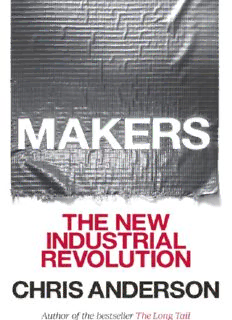
Makers: the new industrial revolution PDF
Preview Makers: the new industrial revolution
Copyright © 2012 by Chris Anderson All rights reserved. Published in the United States by Crown Business, an imprint of the Crown Publishing Group, a division of Random House, Inc., New York. www.crownpublishing.com CROWN BUSINESS is a trademark and CROWN and the Rising Sun colophon are registered trademarks of Random House, Inc. Library of Congress Cataloging-in-Publication Data Anderson, Chris. Makers : the new industrial revolution / Chris Anderson. p. cm. 1. Entrepreneurship. 2. Microfabrication. 3. Micromachining. 4. Business enterprises— Technological innovations. I. Title. HB615.A683 2013 338′.04—dc23 2012014398 eISBN: 978-0-30772097-9 Jacket creative direction and design by Brandon Kavulla v3.1 For Carlotta Anderson Contents Cover Title Page Copyright Dedication Part One THE REVOLUTION Chapter 1 The Invention Revolution Chapter 2 The New Industrial Revolution Chapter 3 The History of the Future Chapter 4 We Are All Designers Now Chapter 5 The Long Tail of Things Part Two THE FUTURE Chapter 6 The Tools of Transformation Four Desktop Factories Chapter 7 Open Hardwares Chapter 8 Reinventing the Biggest Factories of All Chapter 9 The Open Organization Chapter 10 Financing the Maker Movement Chapter 11 Maker Businesses Chapter 12 The Factory in the Cloud Chapter 13 DIY Biology Epilogue The New Shape of the Industrial World Appendix: The 21st-Century Workshop Getting started with CAD Getting started with 3-D printing Getting started with 3-D scanning Getting started with laser cutting Getting started with CNC machines Getting started with electronics Acknowledgments Notes Chapter 1 The Invention Revolution Fred Hauser, my maternal grandfather, emigrated to Los Angeles from Bern, Switzerland, in 1926. He was trained as a machinist, and perhaps inevitably for Swiss mechanical types, there was a bit of the watchmaker in him, too. Fortunately, at that time the young Hollywood was something of a clockwork industry, too, with its mechanical cameras, projection systems, and the new technology of magnetic audio strips. Hauser got a job at MGM Studios working on recording technology, got married, had a daughter (my mom), and settled in a Mediterranean bungalow on a side street in Westwood where every house had a lush front lawn and a garage in the back. But Hauser was more than a company engineer. By night, he was also an inventor. He dreamed of machines, drew sketches and then mechanical drawings of them, and built prototypes. He converted his garage to a workshop, and gradually equipped it with the tools of creation: a drill press, a band saw, a jig saw, grinders, and, most important, a full-size metal lathe, which is a miraculous device that can, in the hands of an expert operator, turn blocks of steel or aluminum into precision-machined mechanical sculpture ranging from camshafts to valves. Initially his inventions were inspired by his day job, and involved various kinds of tape-transport mechanisms. But over time his attention shifted to the front lawn. The hot California sun and the local mania for perfect green-grass plots had led to a booming industry in sprinkler systems, and as the region grew prosperous, gardens were torn up to lay irrigation systems. Proud homeowners came home from work, turned on the valves, and admired the water-powered wizardry of pop-up rotors, variable-stream nozzles, and impact sprinkler heads spreading water beautifully around their plots. Impressive, aside from the fact that they all required manual intervention, if nothing more than just to turn on the valves in the first place. What if they could be driven by some kind of clockwork, too? Patent number 2311108 for “Sequential Operation of Service Valves,” filed in 1943, was Hauser’s answer. The patent was for an automatic sprinkler system, which was basically an electric clock that turned water valves on and off. The clever part, which you can still find echoes of today in lamp timers and thermostats, is the method of programming: the “clock” face is perforated with rings of holes along the rim at each five-minute mark. A pin placed in any hole triggers an electrical actuator called a solenoid, which toggles a water valve on or off to control that part of the sprinkler system. Each ring represented a different branch of the irrigation network. Together they could manage an entire yard— front, back, patio, and driveway areas. Once he had constructed the prototype and tested it in his own garden, Hauser filed his patent. With the patent application pending, he sought to bring it to market. And there was where the limits of the twentieth-century industrial model were revealed. It used to be hard to change the world with an idea alone. You can invent a better mousetrap, but if you can’t make it in the millions, the world won’t beat a path to your door. As Marx observed, power belongs to those who control the means of production. My grandfather could invent the automatic sprinkler system in his workshop, but he couldn’t build a factory there. To get to market, he had to interest a manufacturer in licensing his invention. And that is not only hard, but requires the inventor to lose control of his or her invention. The owners of the means of production get to decide what is produced. In the end, my grandfather got lucky—to a point. Southern California was the center of the new home irrigation industry, and after much pitching, a company called Moody agreed to license his automatic sprinkler system. In 1950 it reached the market as the Moody
Description: